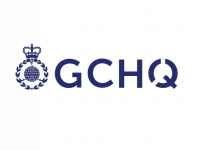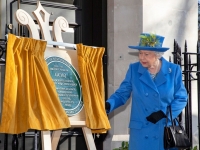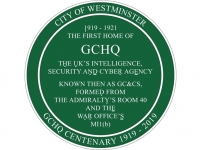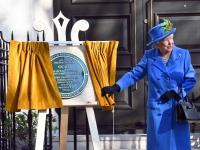News
GCHQ Centenary at Watergate House
Visited by Her Majesty The Queen
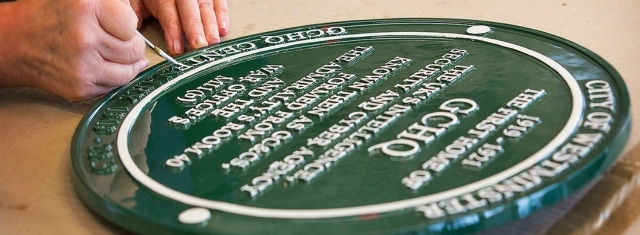
The GCHQ Centenary Plaque (Source: ©GCHQ 2019)
USPA NEWS -
Her Majesty The Queen visited the original top-secret home of GCHQ today, as part of the centenary celebrations for the UK's intelligence, security, and cyber agency.
The event - commemorating our 100 years at the heart of the nation's security - took place at Watergate House, the 1919 birthplace of the organisation.
The event - commemorating our 100 years at the heart of the nation's security - took place at Watergate House, the 1919 birthplace of the organisation.
As part of GCHQ's year-long celebrations, Her Majesty unveiled an historic plaque containing two secret, hidden messages - a nod to the code-breaking minds who established the agency one hundred years ago and the ingenuity that still runs through the organisation today.
Her Majesty toured the premises with the Director GCHQ, Jeremy Fleming. As well as viewing a series of historic artefacts spanning GCHQ's organisation's history, they met the grandchildren of first head Alastair Denniston, and two generations of code-breaking women - including Bletchley Park veteran Ruth Bourne, and the young winners of the 2018 CyberFirst Girls' competition.
Her Majesty toured the premises with the Director GCHQ, Jeremy Fleming. As well as viewing a series of historic artefacts spanning GCHQ's organisation's history, they met the grandchildren of first head Alastair Denniston, and two generations of code-breaking women - including Bletchley Park veteran Ruth Bourne, and the young winners of the 2018 CyberFirst Girls' competition.
Director GCHQ Jeremy Fleming said:
"It's an honour to have Her Majesty the Queen recognise this historic occasion as we celebrate 100 years of GCHQ helping to keep the country safe.
"Our history is full of amazing intelligence, world-leading innovation, and most of all ingenious minds.
"It's a history defined by a belief that with the right mix of minds, anything is possible. As we enter our second century, and we race to remain ahead of our adversaries in the cyber age, it's our brilliant work that still defines us today."
GCHQ, or the Government Code & Cypher School (GC&CS) as it was known at the time, was established on 1 November 1919 as a peacetime cryptanalytic unit made up from staff from the Admiralty's Room 40 and the War Office's MI1(b).
During WWII, GCHQ staff moved to Bletchley Park where they decrypted German messages, most famously by breaking Enigma-encrypted communications, making a significant contribution to the Allied victory.
We now have sites across the country, including Bude, Scarborough, Harrogate, Lincolnshire, and London, and we will be opening a new facility in Manchester later this year.
"It's an honour to have Her Majesty the Queen recognise this historic occasion as we celebrate 100 years of GCHQ helping to keep the country safe.
"Our history is full of amazing intelligence, world-leading innovation, and most of all ingenious minds.
"It's a history defined by a belief that with the right mix of minds, anything is possible. As we enter our second century, and we race to remain ahead of our adversaries in the cyber age, it's our brilliant work that still defines us today."
GCHQ, or the Government Code & Cypher School (GC&CS) as it was known at the time, was established on 1 November 1919 as a peacetime cryptanalytic unit made up from staff from the Admiralty's Room 40 and the War Office's MI1(b).
During WWII, GCHQ staff moved to Bletchley Park where they decrypted German messages, most famously by breaking Enigma-encrypted communications, making a significant contribution to the Allied victory.
We now have sites across the country, including Bude, Scarborough, Harrogate, Lincolnshire, and London, and we will be opening a new facility in Manchester later this year.
Mr Fleming added:
"Our work is not glamorous, or easily portrayed in film. But over the last one hundred years it has saved countless lives, shortened wars, given Britain an edge, and solved or harnessed some of the world's hardest technology challenges.
"It's clear to us all that the world is changing at an unprecedented rate. It's more interconnected than ever before. And this is driving extraordinary opportunity, innovation and progress. It's also unleashing amazing complexity, uncertainty and risk.
"To keep up in this digital era - to optimise the potential of technologies like Artificial Intelligence and Quantum computing - we know we need to keep reinventing. This means making the most of the unique talent we have in GCHQ.
"If we get this right - and I'm confident we will - the prize is a new kind of security and intelligence mission fit for our second century. "
"Our work is not glamorous, or easily portrayed in film. But over the last one hundred years it has saved countless lives, shortened wars, given Britain an edge, and solved or harnessed some of the world's hardest technology challenges.
"It's clear to us all that the world is changing at an unprecedented rate. It's more interconnected than ever before. And this is driving extraordinary opportunity, innovation and progress. It's also unleashing amazing complexity, uncertainty and risk.
"To keep up in this digital era - to optimise the potential of technologies like Artificial Intelligence and Quantum computing - we know we need to keep reinventing. This means making the most of the unique talent we have in GCHQ.
"If we get this right - and I'm confident we will - the prize is a new kind of security and intelligence mission fit for our second century. "
The wording on the plaque says: "1919 - 1921. The first home of GCHQ. The UK's intelligence security and cyber agency. Known then as GC&CS, formed from the Admiralty's Room 40 and the War Office's MI1(b)"
Westminster City Council Member for Sports, Culture and Community, Iain Bott, said:
"It's not often that we get the opportunity to publicly acknowledge the hard work of our intelligence and security services.
"This plaque, which marks the birthplace of one of the country's most important and iconic institutions, will be of enormous interest to visitors as we shed a little light on the history of GCHQ."
Westminster City Council Member for Sports, Culture and Community, Iain Bott, said:
"It's not often that we get the opportunity to publicly acknowledge the hard work of our intelligence and security services.
"This plaque, which marks the birthplace of one of the country's most important and iconic institutions, will be of enormous interest to visitors as we shed a little light on the history of GCHQ."
more information: https://www.gov.uk
Liability for this article lies with the author, who also holds the copyright. Editorial content from USPA may be quoted on other websites as long as the quote comprises no more than 5% of the entire text, is marked as such and the source is named (via hyperlink).

